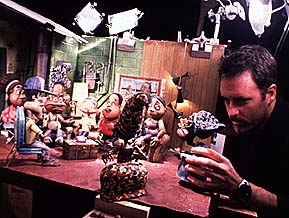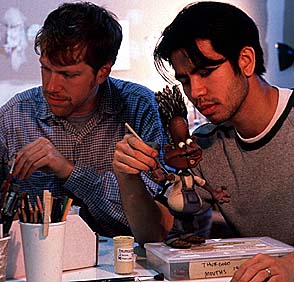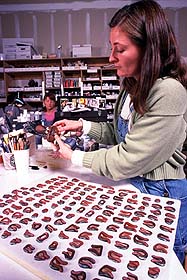|
|
 |
A PJs Chat
|
 |
| Mark Gustafson.© FOX Broadcasting Company. | © FOX Broadcasting Company. |
by Amid Amidi
 |
| Mark Gustafson on The PJs living room set. Photo by Jim Lommasson. |
I had the opportunity to speak with 17-year Vinton Studio veteran Mark Gustafson who is currently the supervising director of The PJs. Over the years, Gustafson has produced a diverse body of work at Will Vinton Studios including the multiple-award winning shorts Mr. Resistor and Bride of Resistor, as well as directing the famous California Raisins spots and the Van Halen-inspired Nissan "Toys" commercial. Even with his long list of credits and years of experience, he admits the prospect of doing a stop motion series is daunting. "It seems like a bad idea to even attempt doing this much stop motion. My concern was, `How are we going to maintain the quality?' I've done so many commercials and they take forever. There's no way we could have done this if we'd approached it the way we do commercials. We had to invent a way to do the show that would really keep the quality because nobody here is interested in doing shlop. So what we tried to do is streamline every aspect of production so that it was all focused on the animation. What it comes down to is getting the animator on the set and in front of a camera so they don't have to bother with anything else."
 |
| (l. to r.) Nelson Lowry, Character Manager, and Dahn Nguyen, Character Wrangler, paint Thurgood. Photo by Jim Lommasson. |
Gustafson's job as supervising director is to make sure that "there is a continuity between the look and feel of the show" amongst the various directors. Gustafson oversees a crew of nearly one hundred people through the entire process - from communicating frequently with the Los Angeles-based writers to making sure the storyboards, animation and final edits all gel together.
One of the first questions that comes to my mind is how the animation work is divided when doing stop motion on such a large scale. "Everybody does every character," says Gustafson. "Some people have a particular skill at doing one character, so maybe when there's a key shot or an emotion that's very critical, we'll try to cast an animator for a specific scene but generally, the shows are divided up into teams. There's typically five animators per episode and they pretty much just work on their episode. It would probably be more efficient if we had animators staying and shooting on individual sets, but we decided to sacrifice that for the investment people get for working on just a single show. They [the animators] get a feeling that it's theirs and they tend to put more of themselves into it that way." The show currently has 20 different animators working on four episodes which are in production concurrently. Approximately two minutes of footage is shot every week on each episode. Episodes generally take 28 weeks to produce from beginning to end with 12 of those weeks spent in the animation phase.
 |
| Katherine Dunn checks Thurgood's various replacement mouths. Photo by Jim Lommasson. |
Inevitably, I have to find out Mark Gustafson's take on the future of stop motion. "It's hard to say. I don't think stop motion will ever be as big as cel or computers. I'm sure stop motion will always have its niche. However, I have my doubts whether it will grow to be the dominant art form in animation." (laughs)
Amid Amidi is the Associate Editor of Animation World Magazine.
Note: Readers may contact any Animation World Magazine contributor by sending an e-mail to editor@awn.com.